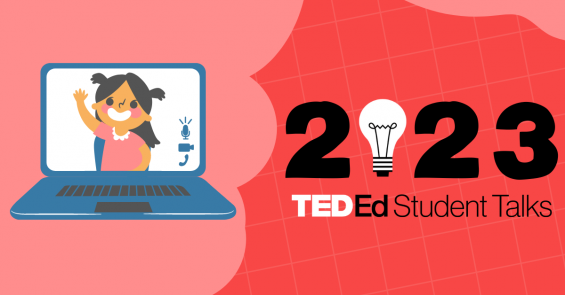
Developing student voice in the ELA classroom
A South Texas school district is inspiring student voices by utilizing the TED-Ed Student Talks curriculum in all their 6th grade writing classrooms.
Here, educator Corinne Spellane discusses how they incorporated the program into the ELA curriculum, and how it helped students find their passion, organize their ideas, build their confidence, and share their own TED-style Talks.
Check out Los Cuates Middle School’s showcase promo and their 2020 Talk showcase.
Rolling out the program
It all started with the little ones! Several of our feeder elementary schools have established TED-Ed Clubs in their after-school programs. When we saw and heard what these kiddos were capable of, we knew we had to help it grow. We decided to start with 6th grade students so that they could rely upon their elementary TED-Ed Club experience.
In Los Fresnos, we provide middle school students with a separate writing class. Preparing for a speech involves organization akin to that required in writing essays and compositions. Therefore it just seemed natural to incorporate the TED-Ed Student Talks curriculum in the writing classes. It was such a treat to watch their ideas snowball from their experience in elementary school!
Making it work in the classroom
The 6th grade ELA department is a pioneering group of eager educators willing to try innovative approaches to give students a voice and strengthen their writing skills. We began by eagerly sifting through the TED-Ed Student Talks Guidebook and other TED-Ed resources. We then reviewed the district’s pacing guide and important dates to establish a basic schedule for the project. Teachers continually shared their feedback and we adjusted accordingly. Once the timeline was established, we set non-negotiable goals and checkpoints to ensure students had adequate time to complete and share their Talks. Teachers had a wide range of negotiable items that allowed them the freedom to make personal and classroom adjustments.
We really had to evaluate our timeline and make the necessary adjustments sometimes on a class-by-class basis. For one class in particular, we noticed that the kids’ passions from Activity 3 in the Guidebook changed after they’d gone through Exploration. This most likely was due to the time and opportunity to think, reflect, and watch more Talks. When they got to the “What are my great ideas?” activity, students found that their passions had evolved. We realized that students need more time to talk out their ideas and reflect on what they truly wanted to say.
One of my favorites was a student who originally identified her passion as “Raising Show Cattle for Future Farmers of America.” After some extended conversation, she eventually discovered that her “great idea” was actually about her feeling of empowerment when showing animals well over a thousand pounds. Her Talk then shifted to the idea of “Girl Power in the Show Ring.”
Additionally, for Exploration 7 around researching the idea, many of the teachers recommended the use of laptops or computer lab time to help with the research process and teachers provided ample class time for research. Some teachers also encouraged students to continue the research process at home. In many cases, students chose to continue their work beyond class time because it was so interesting to them.
Supporting educators
Teachers need patience, flexibility, and time! For some of the activities teachers asked me to join them. It was helpful to have an additional adult in the room to aid the students during specific parts of the process. This was important especially at the beginning when students were coming up with ideas.
My favorite part was watching this process evolve across the three different middle schools. Teachers were able to share and collaborate on their challenges and success while still adding their personal teaching styles. Our group of teachers tried to come together regularly, so that could share our experiences as facilitators, but it was difficult. Fortunately, every middle school had a team of two teachers that were able to collaborate. In the future, it would be very beneficial to have regularly scheduled meetings between the facilitators, and a forum of some kind where teachers could post ideas and suggestions.
Utilizing the Student Talks curriculum
The Student Talks Guidebook was the cornerstone of our timeline. We also watched tons of TED Talks and TEDx Talks to help us through the process. Some of our favorites were: how to grow from underdog to basketball and social media icon, school strike for climate, and the danger of a single story.
Once I gathered all of the materials, we came together to develop our timeline. I first reviewed Idea Book and materials, then worked with teachers to create a timeline and list of resources, which can be seen here: TED Talk Passion Project and Showcase.
The TED-Ed curriculum provides the common core standards, which we don’t use in Texas. But, it was easy to match the activities provided in the Idea Book with our Texas curriculum standards. For example, one Texas Essential Knowledge and Skills standard states, “develop drafts into a focused, structured, and coherent piece of writing by: organizing with purposeful structure, including an introduction, transitions, coherence within and across paragraphs, and a conclusion.” Similarly, the “Discover” section of the TED-Ed Student Talks Idea Journal guides the students through the brainstorming and organizing process in a new and fun way! It was easy to tag our standards with this activity. The kids really didn’t see it as work and it was almost as if we tricked them into writing an essay because they were developing their Talk.
Some parting advice
I recommend that teachers work through the student guide book themselves first to develop their own Talks. If you are able to participate in TED Masterclass that would be even better! Having the experience first really helps you to understand the process and be able to assist your students. Be patient and expect your students to struggle, as this process is challenging and a novel concept for most kids.
Learn more about TED’s global student voice initiative, TED-Ed Student Talks, and how to get involved here.






